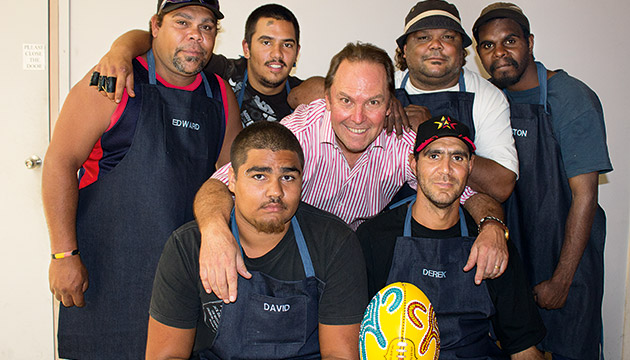The Many Hands Football Project puts a passion for Aussie Rules to work, creating Australian-made footballs and jobs for Indigenous Australians.
Story By Cheryl Critchley
Aboriginal boys were kicking a footy in the dirt in the Northern Territory township of Hermannsburg when they stopped to show Chris Harms their tatty, ripped ball. “They said, ‘Ah mister, do you know how to fix that up?’” Chris recalls in the dusty outback town, which has been trying to make a go of things by attracting visitors to a historic precinct that honours missionaries and locals who once ran industries there, including a tannery. “The lace was all undone and I said, ‘Bingo, that’s the industry that we can build jobs and a work ethic around’,” Chris says.
The former state cricketer and entrepreneur had been looking for ways to help local disadvantaged communities such as Hermannsburg, once the home of artist Albert Namatjira. He’d found that many job programs weren’t working and knew that to engage Indigenous workers he had to be culturally sensitive and find something they were passionate about. What better way than making balls for a sport they loved? Most of the one million Aussie Rules footballs made each year are imported, so for Chris it was a no-brainer.
After pondering his light-bulb moment over a cup of tea in the museum cafe, Chris strolled past an old stone church and the remains of Namatjira’s car. Next to it he found a disused woodwork factory, date farm, market garden, textile factory, blacksmith shop, bakery, cattle station and, remarkably, a tannery that had once made leather goods for R.M.Williams. It really was meant to be.
That was almost two years ago and since then Chris, whose ancestors were among the German missionaries who ran the Hermannsburg Lutheran Mission, has been on his own mission. He spent a year researching problems in local Indigenous communities such as entrenched unemployment, alcoholism and domestic violence, and thought about culturally appropriate ways to tackle them. He started the Many Hands Football Project, which he hopes will produce thousands of balls each year in workshops in and around Alice, including a shed next to the old Hermannsburg tannery.
This story excerpt is from Issue #81
Outback Magazine: Feb/Mar 2012










